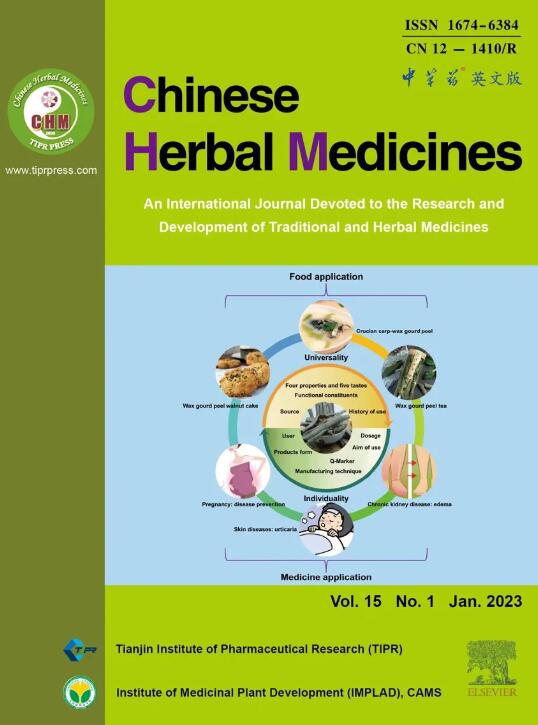Traditional Chinese medicine formulas alleviated acute pancreatitis via improvement of microcirculation: A systematic review and meta-analysis
IF 4.7
4区 医学
Q1 CHEMISTRY, MEDICINAL
引用次数: 0
Abstract
Objective
Microcirculatory disturbance is pathologically critical to acute pancreatitis (AP), which can be effectively alleviated by traditional Chinese medicine (TCM) formulas that activate blood flow. However, there has been no evidence-based research to date. Therefore, a well-designed systematic review and meta-analysis is necessary to elucidate the therapeutic transformative benefit of improving microcirculation during AP. This study aims to confirm the therapeutic efficacy of TCM formulas and explore the potential mechanisms underlying their effects on AP treatment.
Methods
Studies from eight databases including Pubmed, Embase, Web of Science, Cochrane Library, CNKI, CBM, Wanfang, and Chinese VIP, were screened for the eligible randomized controlled trials (RCTs). The APACHE II score and effectiveness rate were set as primary outcomes, while mortality rate, complications, total hospital stays, serum amylase recovery time, the time until the disappearance of abdominal pain, microcirculation indicators, and inflammation indicators were chosen as secondary outcomes. A systematic review and meta-analysis were subsequently conducted. Network pharmacology analysis was performed to analyze potential bioactive components with relevant targets of the core herbs included in the TCM formulas for activating blood flow.
Results
A total of 51 RCTs (n = 3 721) were included. Compared with conventional western medical treatments alone, TCM groups were associated with lower APACHE II score (SMD = − 1.36, 95% CI: −2.01 to − 0.71, P = 0.000) and higher effectiveness rate (RR: 1.22, 95% CI: 1.18 to 1.26, P = 0.000). Furthermore, the formulas for activating blood flow demonstrated significant efficacy in improving both microcirculation and inflammation indicators. Additionally, six core Chinese herbal medicines including Rhei Radix et Rhizoma with the highest frequency, Aurantii Fructus Immaturus, Paeoniae Radix Rubra, Bupleuri Radix, Salviae Miltiorrhizae Radix et Rhizoma, and Corydalis Rhizoma were filtered out from the adopted TCM formulas. Finally, 166 shared targets between the six herbs and AP were identified. KEGG analysis indicated that lipid and atherosclerosis pathway is highly related to microcirculation.
Conclusion
TCM formulas for activating blood flow significantly improve microcirculation and alleviate AP. Further high-quality, well-designed RCTs and deep mechanism exploration are required.
中药方剂通过改善微循环缓解急性胰腺炎:一项系统综述和荟萃分析
目的微循环障碍是急性胰腺炎(AP)的病理关键,中药活血方剂可有效缓解。然而,迄今为止还没有基于证据的研究。因此,有必要进行精心设计的系统评价和荟萃分析,以阐明改善AP期间微循环的治疗转化效益。本研究旨在证实中药方剂的治疗功效,并探讨其治疗AP的潜在机制。方法从Pubmed、Embase、Web of Science、Cochrane Library、CNKI、CBM、万方、Chinese VIP等8个数据库中筛选符合条件的随机对照试验(RCTs)。以APACHEⅱ评分和有效率为主要结局,以死亡率、并发症、总住院时间、血清淀粉酶恢复时间、腹痛消失时间、微循环指标和炎症指标为次要结局。随后进行了系统回顾和荟萃分析。通过网络药理学分析,分析活血方剂中核心药材的潜在生物活性成分与相关靶点。结果共纳入51项rct (n = 3 721)。与单纯西医常规治疗相比,中药组患者APACHEⅱ评分较低(SMD = - 1.36, 95% CI: - 2.01 ~ - 0.71, P = 0.000),有效率较高(RR: 1.22, 95% CI: 1.18 ~ 1.26, P = 0.000)。此外,活血配方在改善微循环和炎症指标方面均有显著疗效。从所采用的中药方剂中筛选出频率最高的大黄、枳实、芍药、柴胡、丹参、延胡索等6种核心中草药。最终鉴定出6种药材与AP共有的166个靶点。KEGG分析表明,脂质和动脉粥样硬化途径与微循环密切相关。结论活血方能明显改善微循环,缓解AP,需进一步开展高质量、设计合理的随机对照试验,深入探讨其机制。
本文章由计算机程序翻译,如有差异,请以英文原文为准。
求助全文
约1分钟内获得全文
求助全文
来源期刊

Chinese Herbal Medicines
CHEMISTRY, MEDICINAL-
CiteScore
4.40
自引率
5.30%
发文量
629
审稿时长
10 weeks
期刊介绍:
Chinese Herbal Medicines is intended to disseminate the latest developments and research progress in traditional and herbal medical sciences to researchers, practitioners, academics and administrators worldwide in the field of traditional and herbal medicines. The journal's international coverage ensures that research and progress from all regions of the world are widely included.
CHM is a core journal of Chinese science and technology. The journal entered into the ESCI database in 2017, and then was included in PMC, Scopus and other important international search systems. In 2019, CHM was successfully selected for the “China Science and Technology Journal Excellence Action Plan” project, which has markedly improved its international influence and industry popularity. CHM obtained the first impact factor of 3.8 in Journal Citation Reports (JCR) in 2023.
 求助内容:
求助内容: 应助结果提醒方式:
应助结果提醒方式:


